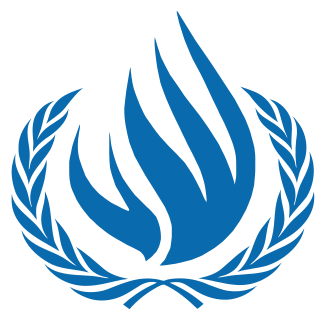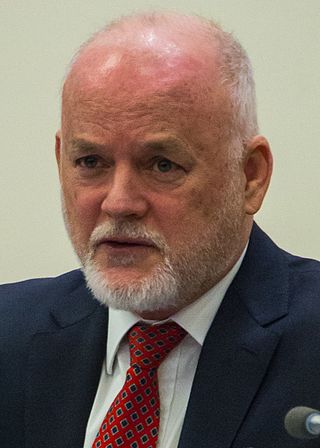Related Research Articles

The United Nations General Assembly is one of the six principal organs of the United Nations (UN), serving as its main deliberative, policymaking, and representative organ. Currently in its 78th session, its powers, composition, functions, and procedures are set out in Chapter IV of the United Nations Charter.

The United Nations Economic and Social Council is one of the six principal organs of the United Nations, responsible for coordinating the economic and social fields of the organization, specifically in regards to the fifteen specialised agencies, the eight functional commissions, and the five regional commissions under its jurisdiction.

The United Nations itself has six principal organs established by the Charter of the United Nations.

The Inter-Parliamentary Union is an international organization of national parliaments. Its primary purpose is to promote democratic governance, accountability, and cooperation among its members; other initiatives include advancing gender parity among legislatures, empowering youth participation in politics, and sustainable development.
Issues relating to the State of Israel and aspects of the Arab–Israeli conflict and more recently the Iran–Israel conflict occupy repeated annual debate times, resolutions and resources at the United Nations. Since its founding in 1948, the United Nations Security Council, has adopted 79 resolutions directly related to the Arab–Israeli conflict as of January 2010.

The United Nations Human Rights Council (UNHRC) is a United Nations body whose mission is to promote and protect human rights around the world. The Council has 47 members elected for staggered three-year terms on a regional group basis. The headquarters of the Council are at the United Nations Office at Geneva in Switzerland.
The United Nations Conciliation Commission for Palestine (UNCCP) or Palestine Conciliation Commission (PCC) was created by UN-resolution 194 of December 11, 1948, with the aim of mediating in the Arab–Israeli conflict. The Commission consisted of France, Turkey and the United States, and its official headquarters was set up in Jerusalem on January 24, 1949. The commission met separately with Israeli and Arab governments from February 12–25, 1949, with Muhammad Nimr al-Hawari of the General Refugee Congress (GRC) and a Palestinian refugee delegation on March 21 in Beirut, and on April 7 in Tel Aviv with Israeli prime minister David Ben-Gurion. It then proposed the Lausanne Conference of 1949.

The Dag Hammarskjöld Library is a library on the grounds of the headquarters of the United Nations, located in the Turtle Bay/East Midtown neighborhood of Manhattan in New York City. It is connected to the Secretariat and Conference buildings through ground level and underground corridors. It is named after Dag Hammarskjöld, the second Secretary-General of the United Nations. The library was founded in 1946, and the current library building was completed in 1961.
Issues relating to the State of Palestine and aspects of the Israeli–Palestinian conflict occupy continuous debates, resolutions, and resources at the United Nations. Since its founding in 1948, the United Nations Security Council, as of January 2010, has adopted 79 resolutions directly related to the Arab–Israeli conflict.
The Yearbook of the United Nations is an annual publication that provides comprehensive coverage of the United Nations' activity for each given year. The Yearbook, which is published by the United Nations Department of Global Communications, stands as "the authoritative reference work on the annual activities and concerns of the Organization." Fully indexed, the Yearbook also includes the texts of all major General Assembly, Security Council, and Economic and Social Council resolutions and decisions, placing them in a unique narrative context of United Nations consideration, deliberation and action. This in-depth narrative of its annual work has been produced by the United Nations since 1946.

Discussions of LGBT rights at the United Nations have included resolutions and joint statements in the United Nations General Assembly and the United Nations Human Rights Council (UNHRC), attention to the expert-led human rights mechanisms, as well as by the UN Agencies.
Defamation of religion is an issue that was repeatedly addressed by some member states of the United Nations (UN) from 1999 until 2010. Several non-binding resolutions were voted on and accepted by the UN condemning "defamation of religion". The motions, sponsored on behalf of the Organization of the Islamic Conference (OIC), now known as the Organisation of Islamic Cooperation, sought to prohibit expression that would "fuel discrimination, extremism and misperception leading to polarization and fragmentation with dangerous unintended and unforeseen consequences". Religious groups, human rights activists, free-speech activists, and several countries in the West condemned the resolutions arguing they amounted to an international blasphemy law. Critics of the resolutions, including human rights groups, argued that they were used to politically strengthen domestic anti-blasphemy and religious defamation laws, which are used to imprison journalists, students and other peaceful political dissidents.
The official languages of the United Nations are the six languages used in United Nations (UN) meetings and in which the UN writes all its official documents.
The Universal Periodic Review (UPR) is a mechanism of the United Nations (UN) Human Rights Council (HRC) that emerged from the 2005 UN reform process. Commonly referred to as the UPR, it was established by General Assembly resolution 60/251 of 3 April 2006, the UPR periodically examines the human rights performance of all 193 UN Member States. It is intended to complement, not duplicate, the work of other human rights mechanisms, including the UN human rights treaty bodies. This is the first international human rights mechanism to address all countries and all human rights. The Working Group on the UPR, which is composed of the HRC's 47 Member States and chaired by the HRC President, conducts country reviews.

The 1980 United Nations Security Council election was held from 20 October to 13 November 1980 during the Thirty-seventh session of the United Nations General Assembly, held at United Nations Headquarters in New York City. The General Assembly elected Ireland, Japan, Panama, Spain, and Uganda, as the five new non-permanent members of the UN Security Council for two-year mandates commencing on 1 January 1981.

The Report of the Commission of Inquiry on Human Rights in the Democratic People's Republic of Korea is the landmark document resulting from the investigations on human rights in North Korea commissioned by the United Nations Human Rights Council in 2013 and concluded in 2014.

The Seventy-first Session of the United Nations General Assembly opened on 13 September 2016. The President of the United Nations General Assembly is from the Asia-Pacific Group.
United Nations General Assembly Resolution 48/144 of 20 December 1993 is a resolution in which the General Assembly expressed its concern at the ongoing degradation of the humanitarian situation in Azerbaijan because of the displacement of considerable number of citizens due to Nagorno Karabakh conflict and supporting "emergency international assistance to refugees and displaced persons in Azerbaijan". The resolution is titled “48/114. Emergency international assistance to refugees and displaced persons in Azerbaijan”. It became the fifth United Nations document concerning Nagorno-Karabakh and the first United Nations General Assembly document on humanitarian aid to those affected by this conflict. This resolution was the first international document affirming the number of refugees and displaced persons in Azerbaijan exceeded one million. The document does not make any specific reference to previous UN resolutions on the ongoing conflict, but "its relevant resolutions regarding humanitarian assistance to refugees and displaced persons". The resolution was adopted by consensus without voting.
United Nations General Assembly Resolution 60/285. By adopting this Resolution, the general Assembly expressed its serious concerns for the environmental damage in the occupied territories of Azerbaijan, and called the organizations and programmes of the United Nations system, in particular, the United Nations Environment Programme to provide all necessary assistance for the rehabilitation of the long-term impact of the environmental degradation of the region.

The United Nations Committee of Experts on Public Administration (CEPA) is an expert body that meets under the auspices of the United Nations Economic and Social Council in order to discuss and find ways to support the work of the Council by providing expert advice on matters concerning governance and public administration structures.
References
- ↑ United Nations Document Series Symbols, 1946-1996. New York, UN, 1998. Document ST/LIB/SER.B/5/Rev. 5. Sales No.: 98.I.6. Bibliographical Series/Dag Hammarskjöld Library; No. 5/Rev.5. Access from Document Symbols : United Nations Documentation (UN). Archived October 16, 2008, at the Wayback Machine
- ↑ UN Documentation : Research Guide : Detailed Table of Contents : United Nations. Dag Hammarskjöld Library
- ↑ United Nations General Assembly Session 56. Report of the Secretary-General.A/56/120/Rev.1,. Re-engineering of the optical disk system.A/56/120/Rev.1 1 October 2001. Retrieved 2008-07-15.
- ↑ United Nations General Assembly Session 56. Report of the Secretary-General.A/C.5/56/12.. Simultaneous availability of parliamentary documentation in electronic form in the six official languages on the United Nations web site.A/C.5/56/12 page 4. 20 November 2001. Retrieved 2008-07-15.
- ↑ United Nations Committee on Information Report of the Secretary General.A/AC.198/2002/2.. Reorientation of United Nations activities in the field of public information and communications.A/AC.198/2002/2. page 16. 25 March 2002. Retrieved 2008-07-15.
- ↑ United Nations Committee on Information Session 26. Report of the Secretary-General Reorientation of United Nations activities in the field of public information and communicationsA/AC.198/2004/2 page 17. 24 February 2004. Retrieved 2008-07-15.
- ↑ United Nations Committee on Information Report of the Secretary-General Modernization and integrated management of United Nations libraries and in-depth review of library activitiesA/AC.198/2004/4 page 11. 17 February 2004. Retrieved 2008-07-15.
- ↑ United Nations Committee on Information Report of the Secretary General The United Nations website: progress towards parity among official languages, accessibility and content managementA/AC.198/2007/3 page 8. 21 February 2007. Retrieved 2008-07-15.
- 1 2 UN Speeches (Meeting Records): SC: UN Archived September 12, 2007, at the Wayback Machine
- ↑ UN General Assembly – Emergency Special Sessions
- ↑ UN Security Council (SC): Overview/Key Documents: UN Archived September 13, 2007, at the Wayback Machine
- ↑ UN Resolutions/Presidential Statements: Security Council (SC): UN Archived September 13, 2007, at the Wayback Machine